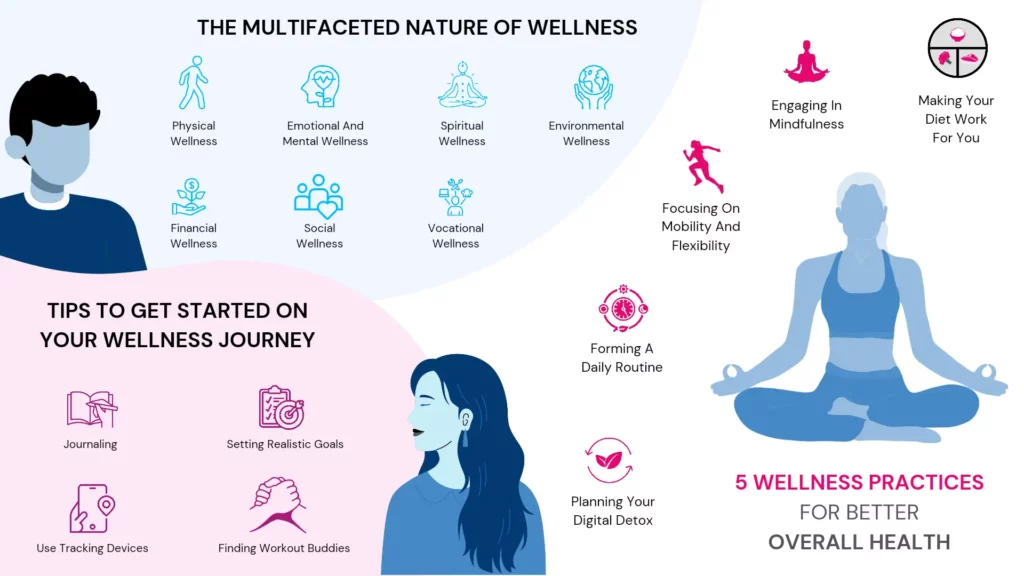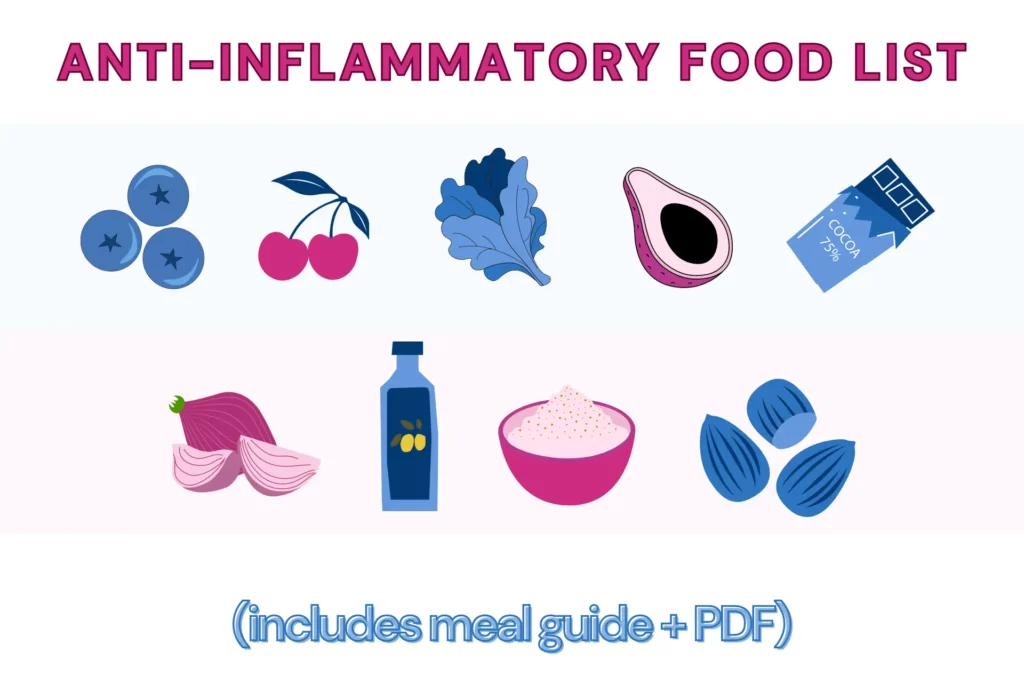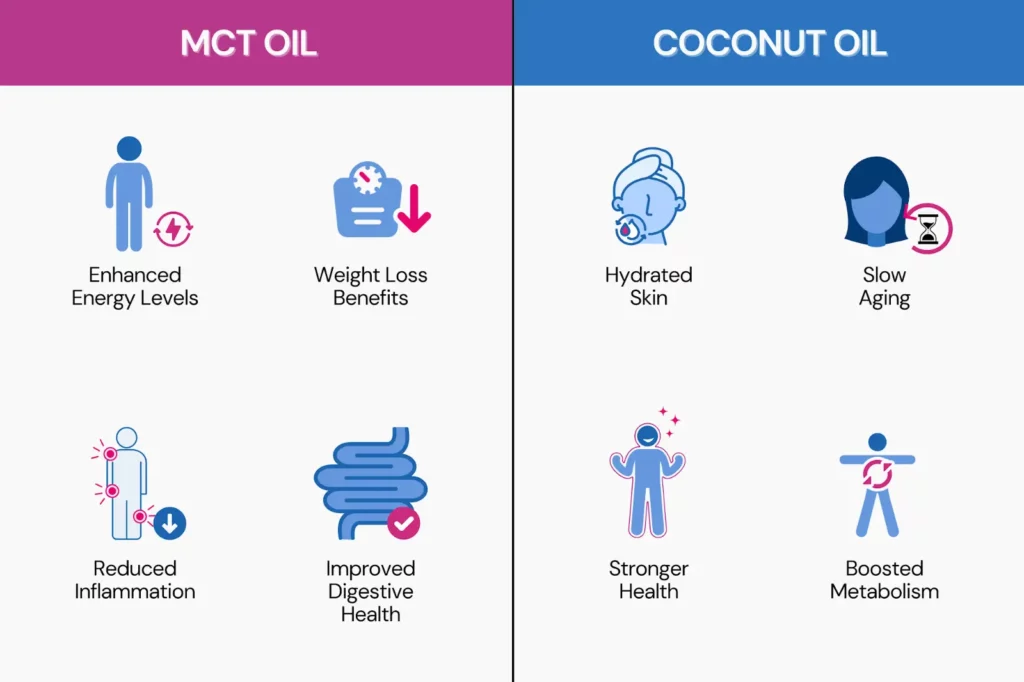Wellness isn't just a buzzword; it's an ongoing journey that many of us are trying to navigate. We've all had those moments where we promise ourselves to start eating healthier, exercise more, or finally get enough sleep, only to find that life gets in the way. The truth is, wellness isn’t a one-size-fits-all approach; it’s about understanding what your body and mind truly need. This National Wellness Month, instead of being overwhelmed by all the advice out there, let’s focus on five simple yet life-changing wellness tips that you can easily integrate into your daily routine. Whether you're looking to improve your physical health, mental clarity, or emotional balance, these tips are designed to help you achieve a well-rounded sense of well-being.
The Multifaceted Nature Of Wellness
When we think of wellness, physical health often comes to mind first.
However, true wellness is a much broader concept, encompassing multiple dimensions that all contribute to our overall well-being.
Here’s a deeper look into the various facets of wellness and how they intertwine to create a balanced and fulfilling life:
Physical Wellness
Physical wellness is about more than just the absence of illness; it’s about thriving.
This dimension includes healthy behaviors like eating a balanced diet, staying active, getting enough sleep, and practicing safe habits.
By making these choices, you not only maintain your body but also set a foundation for a vibrant, energetic life.
Emotional and Mental Wellness
Emotional and mental wellness are the cornerstones of perceiving and responding to life’s challenges.
It’s about understanding and managing your emotions, cultivating resilience, and maintaining a positive outlook.
Good mental health influences every other aspect of wellness, helping you navigate stress, build strong relationships, and find joy in daily life.
Spiritual Wellness
Spiritual wellness is often overlooked, yet it plays a crucial role in finding meaning and purpose.
Nurturing your spiritual side, whether through religion, meditation, or personal reflection, helps you align with your core values and find a sense of direction and inner peace.
Social Wellness
Human connections are vital to our well-being.
Social wellness is about building and maintaining healthy relationships, communicating effectively, and being an active part of your community.
Strong social ties provide support during tough times and enhance the joys of life, contributing to a sense of belonging and security.
Financial Wellness
Financial wellness isn’t just about having enough money; it’s about managing your resources in a way that supports your life goals without causing undue stress.
Understanding how to balance income, savings, and expenses can lead to peace of mind and the freedom to enjoy life rather than being burdened by financial worries.
Vocational Wellness
Vocational wellness goes beyond your job; it’s about finding fulfillment and purpose in what you do.
Whether through your career, hobbies, or volunteer work, using your skills and talents in meaningful ways contributes to your overall sense of achievement and satisfaction.
Environmental Wellness
The environment you live in has a profound impact on your well-being.
Environmental wellness involves creating a living space that nurtures your health and happiness, whether it’s through reducing clutter, connecting with nature, or fostering sustainability.
A positive environment supports your other wellness goals and promotes a sense of peace and harmony.
Wellness is not a single entity but a complex, interconnected web of factors that work together to create a life of balance and fulfillment. By nurturing each of these dimensions, you can build a strong foundation for a healthier, happier life.

National Wellness Month | 5 Wellness Practices For Better Overall Health
With a clear understanding of wellness and its dimensions, let’s look at 5 wellness practices that can improve your overall health!
1. Making Your Diet Work For You
In today’s digital era, there's no shortage of diet and nutrition advice at your fingertips.
Unfortunately, with this abundance comes a flood of misinformation. The truth is, there’s no one-size-fits-all diet that works for everyone.
What works wonders for one person might not yield the same results for another.
This is because our bodies are unique and influenced by factors like lifestyle, environment, and even genetics.
The way your body processes nutrients can differ significantly from someone else’s, meaning a diet that’s effective for one person might not suit your needs at all.
That’s why personalized nutrition is so important. Instead of following the latest diet trend, it’s crucial to understand what your body specifically needs.
Working with a nutritionist can help you tailor a diet plan that aligns with your individual health goals and lifestyle.
Ultimately, the key is to listen to your body and focus on what makes you feel your best rather than relying on generalized advice.
2. Engaging In Mindfulness
Mindfulness and meditation have gained significant recognition for their profound impact on both physical and mental health.
The American Heart Association (AHA) recommends mindfulness practices that involve deep breathing, quiet contemplation, and focused attention as effective tools for reducing stress and enhancing overall well-being.
Research supported by the AHA highlights several benefits of mindfulness, including:
- Reducing inflammation in the body
- Lowering blood pressure levels
- Reducing stress
- Reducing symptoms
- Improving sleep
If you’re new to mindfulness, getting started can be simple and accessible.
Starting with just 5-10 minutes of mindfulness in a comfortable space can help anchor the habit.
There are also online videos on guided mindfulness that can give a boost.
Further, mindfulness is not just about sitting in a place and meditating; try being fully present while engaging in daily activities, such as eating, walking, or even washing dishes.
3. Focusing On Mobility And Flexibility
In the current fitness landscape, strength and weight training have rightfully earned their place in the spotlight.
However, flexibility and mobility often remain overlooked despite being crucial components of a well-rounded fitness routine.
These two aspects of fitness are not just about achieving a deeper stretch or a wider range of motion—they are key to aging gracefully and maintaining independence as we grow older.
Incorporating flexibility and mobility exercises into your routine offers a multitude of benefits:
- Keeps your joints healthy
- Improves agility
- Relieves muscle aches
- Provides stress relief
- Increases the production of endorphins and serotonin (also called the ‘feel good’ hormones)
- Regulates hormones in the body
As we age, the importance of mobility training becomes even more apparent.
Regular flexibility exercises can help ensure that, even in your later years, you maintain the ability to move freely and independently.
This can significantly enhance your quality of life, allowing you to stay active and engaged in the activities you love.
4. Forming A Daily Routine
Humans thrive on routine, and establishing a daily structure can be a powerful tool for improving overall health and well-being.
Doctors and wellness experts worldwide emphasize the importance of having a consistent routine, as it provides numerous benefits beyond just physical health.
Creating and sticking to a daily routine can:
- Reduce stress and anxiety
- Improve sleep quality
- Promote healthier eating habits
- Encourage regular physical activity
- Support mental clarity and focus
Practical Tips for Establishing a Daily Routine
- Start small: Begin by adding one or two new habits to your day, such as a morning stretch or a set time for breakfast. Gradually build on this foundation as you become more comfortable.
- Prioritize your tasks: Identify the most important activities in your day and schedule them first. This ensures that your priorities are always addressed, even if unexpected events arise.
- Set consistent wake-up and bedtimes: Aim to wake up and go to bed at the same time each day, even on weekends. This helps regulate your sleep cycle and improves overall sleep quality.
- Plan your meals: Take some time at the beginning of the week to plan your meals. This not only ensures you’re eating healthily but also saves time and reduces the stress of figuring out what to eat each day.
- Include relaxation and self-care: Make sure your routine includes time for relaxation and activities that you enjoy. This helps to recharge your mind and body, keeping you balanced and preventing burnout.
By forming a daily routine that works for you, you create a framework that supports both your physical and mental well-being.
This consistency not only helps you stay on track with your health goals but also contributes to a more balanced and fulfilling life.
5. Planning Your Digital Detox
In today’s hyperconnected world, we're glued to our screens—whether it’s our phones, laptops, or TVs.
While technology keeps us informed and entertained, too much screen time can start to wear us down, both mentally and physically.
That’s why taking a break with a digital detox can be so refreshing.
A digital detox simply means stepping away from your devices for a while to reconnect with the real world.
It’s about giving your mind a breather from the endless notifications and information overload.
This break can help you feel less stressed, sleep better, and improve your overall well-being.
Here’s how you can make the most of your digital detox:
- Get outside: Swap your screen time for some outdoor activities. Whether it’s a walk in the park, a hike, or just sitting in your backyard, being in nature can do wonders for your mood and energy.
- Spend quality time with loved ones: Use this time to really connect with the people around you. Play a game, have a conversation, or just enjoy each other’s company without the distraction of screens.
- Dive into hobbies and exercise: Pick up a book, try out a new recipe, or get moving with some exercise. Doing something you love or getting your body moving can boost your mood and help you feel more balanced.
- Set some screen boundaries: To make your detox more effective, try setting specific times when you’ll unplug. For example, avoid screens an hour before bed to help wind down.
By regularly taking time away from your screens, you give yourself a chance to recharge and focus on what really matters. It’s a simple step that can make a big difference in how you feel day-to-day.
Tips To Get Started On Your Well-being Journey This National Wellness Month
Tips to Get Started on Your Well-being Journey This National Wellness Month
Now that you have a solid understanding of wellness and the practices that contribute to overall well-being let’s dive into some practical tips to help you kickstart your wellness journey. These tips are designed to be easy to implement and can make a real difference in your daily life.
1. Start Journaling
Journaling is a powerful tool that allows you to articulate and reflect on your thoughts and experiences. It’s more than just writing down your day—it’s about setting clear goals, gaining clarity, and boosting your mental health.
To get started:
- Choose your format: Decide whether you prefer a traditional notebook or a digital journal. Both have their benefits, so pick what feels most comfortable for you.
- Establish a routine: Find a time of day that works best for you to journal consistently, whether it’s in the morning to set your intentions or at night to reflect on your day.
- Start small: Don’t feel pressured to write pages every day. Even a few lines can be impactful.
- Use prompts: If you’re unsure where to begin, try prompts like “What am I grateful for today?” or “What was the most challenging part of my day?”
- Integrate wellness: Use your journal to track your wellness practices and progress. Reflect on how these habits are impacting your overall well-being.
2. Set Realistic Goals
It’s easy to get excited about starting your wellness journey, but it’s important to set goals that are realistic and achievable. The biggest obstacle people face is burnout from setting goals that are too ambitious.
- Break it down: Start with small, manageable steps that you can build on over time. For example, instead of committing to an hour of exercise every day, start with 15 minutes and gradually increase.
- Track your progress: Use your journal or a mobile app to monitor your goals and celebrate small victories along the way.
- Be patient: Wellness is a journey, not a sprint. Allow yourself the grace to progress at your own pace.
3. Use Tracking Devices
In our digital age, we have access to tools that can make our wellness journey more informed and personalized. Fitness trackers and health apps can monitor everything from heart rate to sleep patterns.
- Choose wisely: Pick a device that aligns with your specific wellness goals, whether it’s improving your sleep, tracking your exercise, or monitoring stress levels.
- Stay consistent: Regularly check in with your tracker to see how your body is responding to your wellness practices.
- Use data wisely: Use the insights from these devices to make informed decisions about your health, adjusting your routine as needed.
4. Find Workout Buddies
Staying motivated can be tough when you’re on your own, which is why finding a workout buddy or joining a community can be so beneficial.
- Look for like-minded people: Whether it’s a friend, a family member, or a local group, find people who share similar wellness goals.
- Build accountability: Having someone to exercise with not only makes the activity more enjoyable but also keeps you accountable.
- Share your journey: Working out with others creates a sense of camaraderie and emotional support, which is essential for long-term wellness.
By integrating these tips into your daily life, you can create a strong foundation for your wellness journey. Remember, it’s all about making small, consistent changes that add up to big improvements in your overall health and well-being.
Summary: National Wellness Month
- Wellness is Multifaceted: Wellness involves balancing physical, emotional, mental, spiritual, social, financial, vocational, and environmental health to achieve overall well-being.
- Personalized Nutrition: With so much dietary advice available, it's crucial to tailor your diet to your unique needs, considering factors like lifestyle, environment, and genetics. Personalized nutrition helps optimize your health.
- Mindfulness Practices: Regular mindfulness practices like meditation and deep breathing can reduce stress, improve sleep, and enhance both mental and physical well-being.
- Flexibility and Mobility: While strength training is important, incorporating flexibility and mobility exercises into your routine is essential for joint health, reducing muscle tension, and aging gracefully.
- Establishing a Daily Routine: A well-structured daily routine can reduce stress, improve sleep, and support healthy habits.
- Embracing a Digital Detox: A digital detox encourages reconnecting with nature, engaging in physical activities, and strengthening personal relationships, contributing to better overall well-being.
- Getting Started on Your Well-being Journey: Start by journaling to reflect on your thoughts and track progress, set realistic goals to avoid burnout, use tracking devices to monitor your health, and find workout buddies to stay motivated. These tips provide a practical foundation for enhancing your overall well-being.
Others Are Also Reading

Low-calorie High-volume Foods: The Key To Feeling Fuller For Longer

The Ultimate Guide To Anti-inflammatory Diet + Food List PDF

MCT Oil vs. Coconut Oil: Differences In Benefits And Risks
References
- https://students.wlu.ca/wellness-and-recreation/health-and-wellness/wellness-education/dimensions.html
- https://www.heart.org/en/healthy-living/healthy-lifestyle/mental-health-and-wellbeing/meditation-to-boost-health-and-wellbeing
- https://psu.pb.unizin.org/kines61psusl/chapter/flexibility/
- https://www.nm.org/healthbeat/healthy-tips/health-benefits-of-having-a-routine
- https://www.ncbi.nlm.nih.gov/pmc/articles/PMC6305886/
- https://www.aao.org/physician-wellness/goal-tracking-tools




